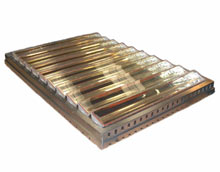Solar Power at Half the Cost
A new mechanism for focusing light on small areas of photovoltaic material could make solar power in residential and commercial applications cheaper than electricity from the grid in most markets in the next few years. Initial systems, which can be made at half the cost of conventional solar panels, are set to start shipping later this year, says Brad Hines, CTO and founder of Soliant Energy, a startup based in Pasadena, CA, that has developed the new modules.

Concentrating sunlight with mirrors or lenses on a small area cuts the costs of solar power in part by reducing the amount of expensive photovoltaic material needed. But while concentrated solar photovoltaic systems are attractive for large-scale, ground-based solar farms for utilities, conventional designs are difficult to mount on rooftops, where most residential and commercial customers have space for solar panels. The systems are typically large and heavy, and they’re mounted on posts so that they can move to track the sun, which makes them more vulnerable to gusts of wind than ordinary flat solar panels are.
Soliant has designed a solar concentrator that tracks the sun throughout the day but is lighter and not pole-mounted. The system fits in a rectangular frame and is mounted to the roof with the same hardware that’s used for conventional flat solar panels. Yet the devices will likely cost half as much as a conventional solar panel, says Hines. A second-generation design, which concentrates light more and uses better photovoltaics, could cost a quarter as much. He says that a more advanced design should be ready by 2010.
The Soliant design combines both lenses and mirrors to create a more compact system. Each module is made of rows of aluminum troughs, each about the width and depth of a gutter. These troughs are mounted inside a rectangular frame and can tilt in unison from side to side to follow the sun. Each trough is enclosed on top with a clear acrylic lid. Inside each trough, a strip of silicon photovoltaic material runs along the bottom. As light enters, some of it reflects off the inside surface of the trough and reaches the strip of silicon. The rest of the incoming light is focused on the strip by a lens incorporated into the acrylic lid.
Multimedia
View a slideshow of solar concentrator images and schematics.
As a solar concentrating system, this design has a few drawbacks. Because the troughs are mounted close together, they shade each other during parts of the day, decreasing the total amount of electricity produced. They can also only track from side to side, which makes it impossible for them to follow exactly the arc of the sun across the sky. This second problem will be addressed in the second-generation design, in which each trough will be divided into sections, each of which can pivot from side to side and also up and down.
But the ease of installation could help convince solar installers to use the technology, says Craig Cornelius, the technology manager for the Department of Energy’s (DOE) solar-energy technology program. DOE recently announced $168 million in funding for 13 solar projects, under which Soliant will receive up to $4 million. Cornelius says that the lower installation costs will help reduce the overall costs of solar power from the modules.
Cornelius thinks that some customers, such as those with plenty of roof space, will opt for cheaper, thin-film solar panels, which in some cases can double as shingles, but are less efficient than conventional solar panels. But for those who need more power for the space they have, Cornelius says that Soliant’s approach may prove the best option. Its modules produce as much power as conventional flat panels but are less expensive, using 88 percent less silicon. The company’s next-generation system would be even better, producing three times as much power per area.
To test the panels, Soliant is working with DOE and Sun Edison, an established solar-system installer and operator based in Beltsville, MD. The second-generation system will be even more challenging to develop because light will be focused on a smaller area, requiring better tracking of the sun. Soliant will also be working with Emanuel Sachs, professor of mechanical engineering at MIT, to improve manufacturing techniques and the system for aiming the concentrators.
“In some ways, what’s interesting about [Soliant’s] approach is [that] the engineering issues they have to solve are relatively mundane,” Cornelius says. “This is one of the projects that I’m most excited about in our whole portfolio.”
Keep Reading
Most Popular
Large language models can do jaw-dropping things. But nobody knows exactly why.
And that's a problem. Figuring it out is one of the biggest scientific puzzles of our time and a crucial step towards controlling more powerful future models.
The problem with plug-in hybrids? Their drivers.
Plug-in hybrids are often sold as a transition to EVs, but new data from Europe shows we’re still underestimating the emissions they produce.
Google DeepMind’s new generative model makes Super Mario–like games from scratch
Genie learns how to control games by watching hours and hours of video. It could help train next-gen robots too.
How scientists traced a mysterious covid case back to six toilets
When wastewater surveillance turns into a hunt for a single infected individual, the ethics get tricky.
Stay connected
Get the latest updates from
MIT Technology Review
Discover special offers, top stories, upcoming events, and more.